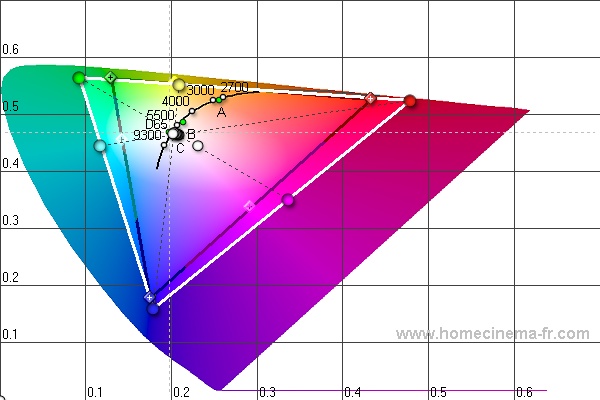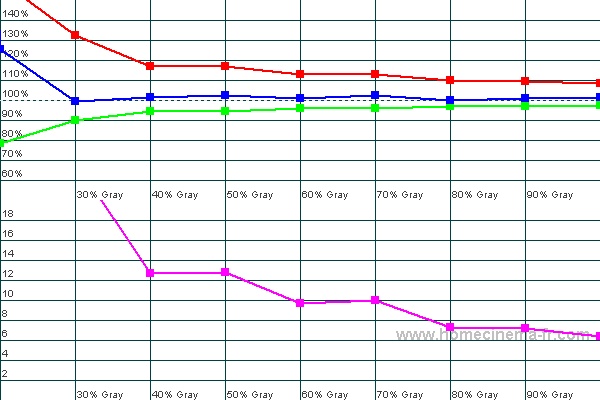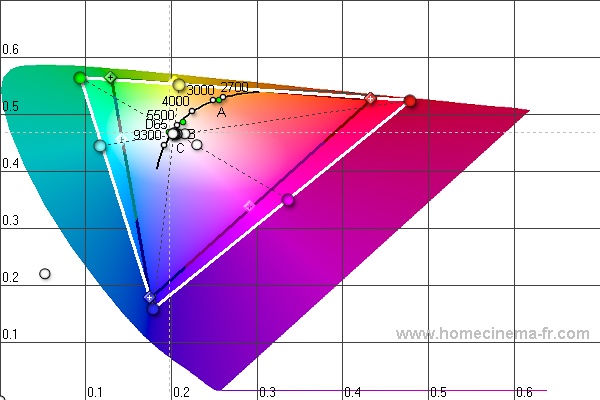So, I’ve finally got around to doing a few sensor based measurements. I still need to sit down and digest the Basic Guide to Colour Calibration using a CMS (Colour Management System) before I start trying to make changes.
For a 100IRE full screen field, I measured 12flL. This is pretty impressive considering I’m using the darkest mode, and the projector is mounted 17 feet from the screen.
I have noted visually that there seems to be a bit of colour shift from left to right, the sensor measurements verified this. The left of the screen is more blue, and the right is more red.
All of these measurements are really just out of the box performance, I haven’t even logged 10 hours yet. The bulb timer still reads 0H, and as confirmed by Epson support, it will not start showing different until I’m past 10H.
I did run through the basic brightness, contrast and sharpness settings using AVIA. The Theater Black 2 default settings were basically correct, so I left them alone.
So here is a CIE u,v chart, showing both the measured grayscale with primary and secondary colours.
So the good news here is that the 1080UB is capable of covering the complete REC601 colour space (not all digital projectors are able to do this), however out of the box – its fairly far off. Certainly watchable, but I’ll be happier when its tweaked a bit more.
More details follow..
Calibration Equipment:
- Spyder2 – tripod mounted, sensor pointed at screen
- ColorHCRF v2.0
Measured Equipment:
- Epson 1080UB, Color mode – Theater Black 2 – with defaults
- Draper CinePerm M1300 80×45
- Sony DVP-NS50P connected to UB direct with component, 480p
- Room 100% light control, black and dark gray
The Spyder2 gets bashed a bit for being less accurate than other relatively economical sensors. It is the one I’ve got currently – and it is just less accurate, not inaccurate. I’ve been using it with the LCD grate in place.
Tonight I experimented with moving the tripod around and making minor adjustments to the positioning of the sensor. I wanted to see if this had a radical impact on readings, thus possibly skewing the data due to placement. From what I measured, it seems fairly reliable, providing results within 2%.
Near black measurements are a problem with the Spyder2. It was reading 0.000flL for 0IRE and 10IRE fields. Bumping up to 20IRE gave me 0.110flL, which based on the graphs is on the edge of where the sensor is useful. For tuning grayscale I stick to the 30IRE to 70IRE range.
I did two sets of measurements, in two different sessions. So I’ve got two sets of charts, which compare fairly well. First we’ll look at the RBG and delta E charts:
What stands out here is the inaccuracy of the Spyder2 at low IRE. There is clearly more red than we want.
The second set of charts are the CIE charts. Forgive me for repeating the 1st one from above:
I’m still learning to read these, but they are fairly consistent which is a good thing. It means my measurement process is repeatable from one night to another, so when I do effect change it should be somewhat sane.
I suspect that like panel convergence (I believe mine is acceptable) you likely can’t do much about the colour shift from left to right. I am pretty pleased with the 12ftL reading as this is considered fairly ideal, and as I’m in low brightness mode as the bulb ages I can bump it up if I need to.




